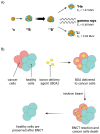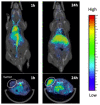In Vivo Application of Carboranes for Boron Neutron Capture Therapy (BNCT): Structure, Formulation and Analytical Methods for Detection
- PMID: 37894311
- PMCID: PMC10605826
- DOI: 10.3390/cancers15204944
In Vivo Application of Carboranes for Boron Neutron Capture Therapy (BNCT): Structure, Formulation and Analytical Methods for Detection
Abstract
Carboranes have emerged as one of the most promising boron agents in boron neutron capture therapy (BNCT). In this context, in vivo studies are particularly relevant, since they provide qualitative and quantitative information about the biodistribution of these molecules, which is of the utmost importance to determine the efficacy of BNCT, defining their localization and (bio)accumulation, as well as their pharmacokinetics and pharmacodynamics. First, we gathered a detailed list of the carboranes used for in vivo studies, considering the synthesis of carborane derivatives or the use of delivery system such as liposomes, micelles and nanoparticles. Then, the formulation employed and the cancer model used in each of these studies were identified. Finally, we examined the analytical aspects concerning carborane detection, identifying the main methodologies applied in the literature for ex vivo and in vivo analysis. The present work aims to identify the current strengths and weakness of the use of carboranes in BNCT, establishing the bottlenecks and the best strategies for future applications.
Keywords: COSAN; anticancer treatments; boron agents; boron neutron capture therapy (BNCT); cancer; carboranes; chemical conjugates; delivery systems; in vivo; metallacarboranes.
Conflict of interest statement
The authors declare no conflict of interest.
Figures


















References
-
- Wang L.W., Liu Y.W.H., Chu P.Y., Liu H.M., Peir J.J., Lin K.H., Huang W.S., Lo W.L., Lee J.C., Lin T.Y., et al. Boron Neutron Capture Therapy Followed by Image-Guided Intensity-Modulated Radiotherapy for Locally Recurrent Head and Neck Cancer: A Prospective Phase I/II Trial. Cancers. 2023;15:2762. doi: 10.3390/cancers15102762. - DOI - PMC - PubMed
Publication types
Grants and funding
LinkOut - more resources
Full Text Sources

